The software carries out the central control of the passive avoidance-based learning, and the automatic processing of data obtained from experiments. The software supports the known steps in the protocol, like habituation, learning and testing.
The software can control up to six classical two-compartment boxes (shuttle box). Each box can be adjusted independently.
The software and boxes communicating via USB.
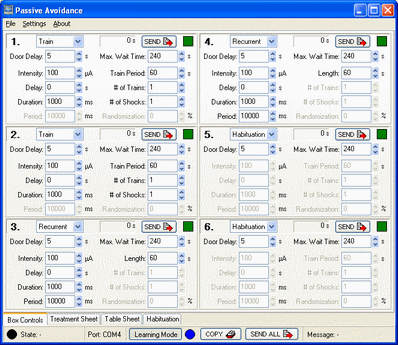 The central part of the software is the Box Controller, which contains parameter-fields to setup the experiment. The intelligent CPU-controlled boxes can be set through this function.
The central part of the software is the Box Controller, which contains parameter-fields to setup the experiment. The intelligent CPU-controlled boxes can be set through this function.
The following parameters can be set:
- Experiment Mode (Train / Recurrent / Habituation)
- Door Delay
- Intensity
- Delay
- Duration
- Period
- Wait Time
- Number of Trains
- Train Period
- Number of Shocks
- Randomization
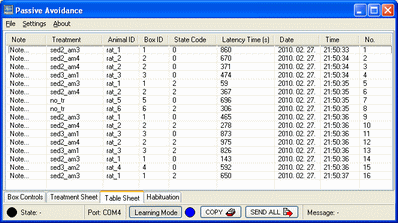 The experimental process can be followed on the screen, data are displayed continuously and placed automatically in the integrated data acquisition table. When experimental process is done, the boxes send the result to the PC.
The experimental process can be followed on the screen, data are displayed continuously and placed automatically in the integrated data acquisition table. When experimental process is done, the boxes send the result to the PC.
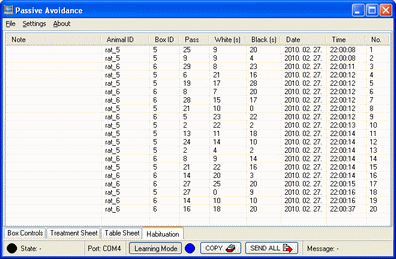 Besides the standard learning test, it is possible to observe habituation too. Habituation experiment data will be placed in the Habituation datasheet. This table contains, inter alia, the number of passes and the sum of precise time, which has been filled in the individual compartments.
Besides the standard learning test, it is possible to observe habituation too. Habituation experiment data will be placed in the Habituation datasheet. This table contains, inter alia, the number of passes and the sum of precise time, which has been filled in the individual compartments.
Both controller-settings and datasheets can be save into setup files, so later can be open the desired file, and the previously performed settings and data become immediately active.
Stimulation settings
It is possible to set complex stimulation sequences.
From two basic stimulation mode can choose: Train or Recurrent.
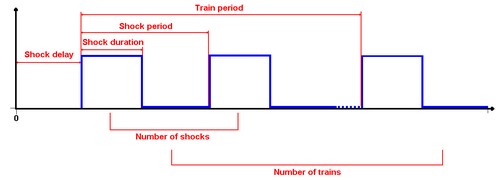 During Train stimulation, sequences may be any number of stimuli.
In this mode, defined number of pulse sequences is repeating with given period. The pulse sequences are stand of defined number, width and period pulses.
The period parameter is legal, if the number of shocks is greater than one. The same applies to the Number of Trains and Train Period as well.
During Train stimulation, sequences may be any number of stimuli.
In this mode, defined number of pulse sequences is repeating with given period. The pulse sequences are stand of defined number, width and period pulses.
The period parameter is legal, if the number of shocks is greater than one. The same applies to the Number of Trains and Train Period as well.
The Randomization sets the interval between two Train-sequence in a calculated time-range by randomly. In this case, the Train period is changing randomly.
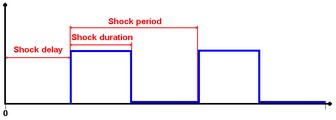 During Recurrent stimulation, the pulses are coming constantly from the start of stimulation in the whole lenght of sessions. In this case, only the delay (startup time-shift compared to the beginning of the section), the pulse width and the period is adjustable. This method should be used for example in the learned helplessness experiments.
During Recurrent stimulation, the pulses are coming constantly from the start of stimulation in the whole lenght of sessions. In this case, only the delay (startup time-shift compared to the beginning of the section), the pulse width and the period is adjustable. This method should be used for example in the learned helplessness experiments.
 The Period defines the time between two consecutive Trains. This parameter can only be set, if more than one stimulation has been defined. In each stage, stimulus-serie of 1..n number of pulse can be given.They are bounded by the length of the section and the sequences.
The Period defines the time between two consecutive Trains. This parameter can only be set, if more than one stimulation has been defined. In each stage, stimulus-serie of 1..n number of pulse can be given.They are bounded by the length of the section and the sequences.
The Duration defines the interval between the rising and falling edge of the square wave pulse (pulse width).
 Number of Shocks gives the number of pulses in one stimulus cycle (Train).
If only one Train and one pulse has been defined, then the whole section stands of a single square wave stimulus.
If more than one Train and just one pulse was determined, then series of single pulses will be generated.
If more than one Train and pulse was determined, then series of Trains will be generated.
Number of Shocks gives the number of pulses in one stimulus cycle (Train).
If only one Train and one pulse has been defined, then the whole section stands of a single square wave stimulus.
If more than one Train and just one pulse was determined, then series of single pulses will be generated.
If more than one Train and pulse was determined, then series of Trains will be generated.
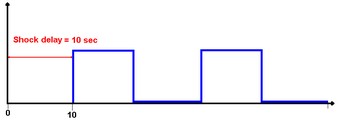 The Delay determines the time interval between the beginning of the section and the beginning of the first stimulus.
If this value is zero, then stimulus starts immediately at the beginning of the section.
The delay can not be greater than the difference between the section-time and the pulse sequence(s) in total length between them.
The Delay determines the time interval between the beginning of the section and the beginning of the first stimulus.
If this value is zero, then stimulus starts immediately at the beginning of the section.
The delay can not be greater than the difference between the section-time and the pulse sequence(s) in total length between them.
 The Number of Trains determines the number of series of stimuli within one section.
The Number of Trains determines the number of series of stimuli within one section.
 The central part of the software is the Box Controller, which contains parameter-fields to setup the experiment. The intelligent CPU-controlled boxes can be set through this function.
The central part of the software is the Box Controller, which contains parameter-fields to setup the experiment. The intelligent CPU-controlled boxes can be set through this function. The experimental process can be followed on the screen, data are displayed continuously and placed automatically in the integrated data acquisition table. When experimental process is done, the boxes send the result to the PC.
The experimental process can be followed on the screen, data are displayed continuously and placed automatically in the integrated data acquisition table. When experimental process is done, the boxes send the result to the PC.
 Besides the standard learning test, it is possible to observe habituation too. Habituation experiment data will be placed in the Habituation datasheet. This table contains, inter alia, the number of passes and the sum of precise time, which has been filled in the individual compartments.
Besides the standard learning test, it is possible to observe habituation too. Habituation experiment data will be placed in the Habituation datasheet. This table contains, inter alia, the number of passes and the sum of precise time, which has been filled in the individual compartments. During Train stimulation, sequences may be any number of stimuli.
In this mode, defined number of pulse sequences is repeating with given period. The pulse sequences are stand of defined number, width and period pulses.
The period parameter is legal, if the number of shocks is greater than one. The same applies to the Number of Trains and Train Period as well.
During Train stimulation, sequences may be any number of stimuli.
In this mode, defined number of pulse sequences is repeating with given period. The pulse sequences are stand of defined number, width and period pulses.
The period parameter is legal, if the number of shocks is greater than one. The same applies to the Number of Trains and Train Period as well. During Recurrent stimulation, the pulses are coming constantly from the start of stimulation in the whole lenght of sessions. In this case, only the delay (startup time-shift compared to the beginning of the section), the pulse width and the period is adjustable. This method should be used for example in the learned helplessness experiments.
During Recurrent stimulation, the pulses are coming constantly from the start of stimulation in the whole lenght of sessions. In this case, only the delay (startup time-shift compared to the beginning of the section), the pulse width and the period is adjustable. This method should be used for example in the learned helplessness experiments.
 The Period defines the time between two consecutive Trains. This parameter can only be set, if more than one stimulation has been defined. In each stage, stimulus-serie of 1..n number of pulse can be given.They are bounded by the length of the section and the sequences.
The Period defines the time between two consecutive Trains. This parameter can only be set, if more than one stimulation has been defined. In each stage, stimulus-serie of 1..n number of pulse can be given.They are bounded by the length of the section and the sequences. Number of Shocks gives the number of pulses in one stimulus cycle (Train).
If only one Train and one pulse has been defined, then the whole section stands of a single square wave stimulus.
If more than one Train and just one pulse was determined, then series of single pulses will be generated.
If more than one Train and pulse was determined, then series of Trains will be generated.
Number of Shocks gives the number of pulses in one stimulus cycle (Train).
If only one Train and one pulse has been defined, then the whole section stands of a single square wave stimulus.
If more than one Train and just one pulse was determined, then series of single pulses will be generated.
If more than one Train and pulse was determined, then series of Trains will be generated.
 The Delay determines the time interval between the beginning of the section and the beginning of the first stimulus.
If this value is zero, then stimulus starts immediately at the beginning of the section.
The delay can not be greater than the difference between the section-time and the pulse sequence(s) in total length between them.
The Delay determines the time interval between the beginning of the section and the beginning of the first stimulus.
If this value is zero, then stimulus starts immediately at the beginning of the section.
The delay can not be greater than the difference between the section-time and the pulse sequence(s) in total length between them.
 The Number of Trains determines the number of series of stimuli within one section.
The Number of Trains determines the number of series of stimuli within one section.